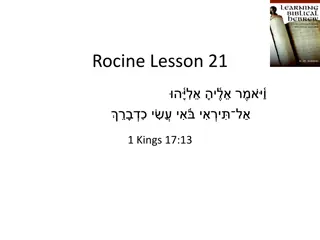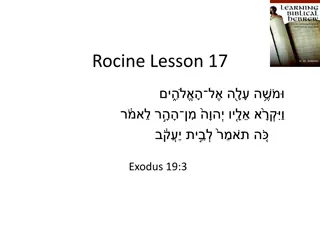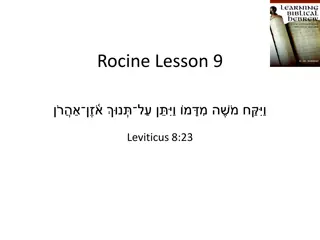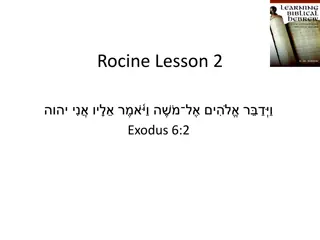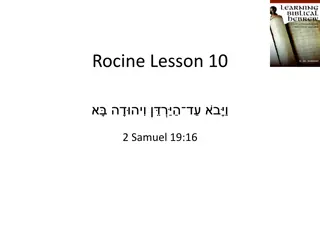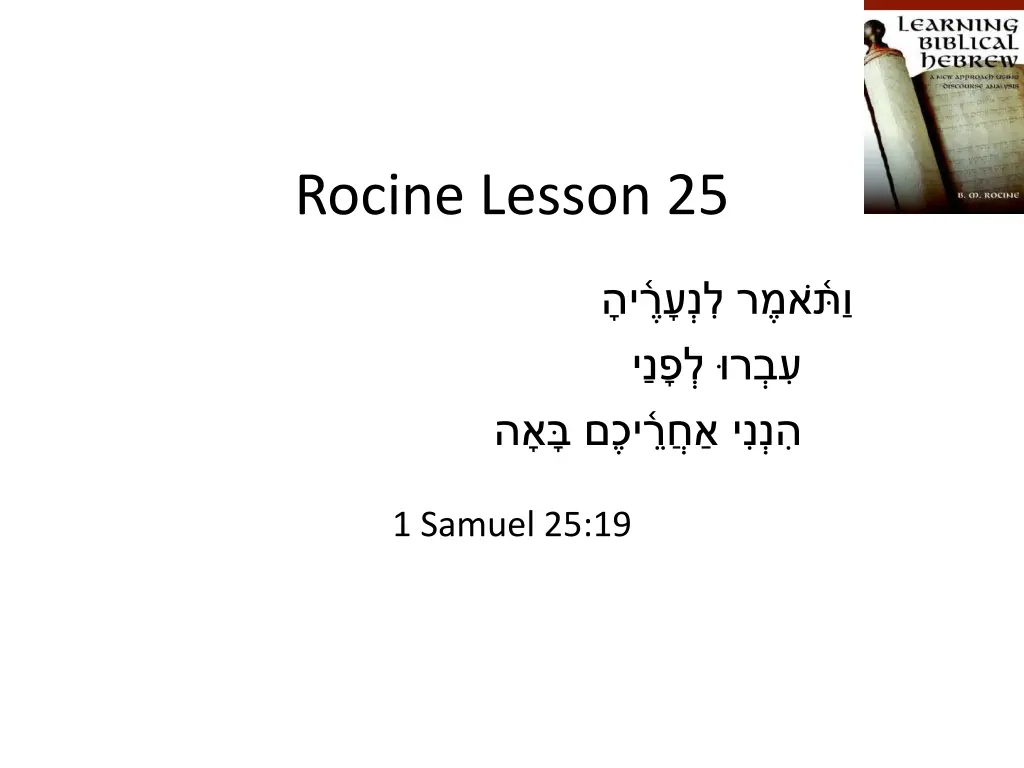
Contrasting Qatals and Participles in Hebrew Verbs
Explore the distinctions between Qatals and Participles of Hollow Roots in Hebrew grammar, focusing on the similar forms and contrasting features, such as singular Qatals and plural Qatals. Understand the nuances and differences between these forms to enhance comprehension and translation skills.
Download Presentation

Please find below an Image/Link to download the presentation.
The content on the website is provided AS IS for your information and personal use only. It may not be sold, licensed, or shared on other websites without obtaining consent from the author. If you encounter any issues during the download, it is possible that the publisher has removed the file from their server.
You are allowed to download the files provided on this website for personal or commercial use, subject to the condition that they are used lawfully. All files are the property of their respective owners.
The content on the website is provided AS IS for your information and personal use only. It may not be sold, licensed, or shared on other websites without obtaining consent from the author.
E N D
Presentation Transcript
Rocine Lesson 25 1 Samuel 25:19
Goals Qal qatal vs. Qal participles of hollow roots Participles as imminent future
What we already know What 2 PGNs can have? What does the sfx at the end of mean? Translate .
What we already know What 2 PGNs can have? What does the sfx at the end of mean? Translate 3fs or 2ms 3fs . She said to her servants
What we already know How can you tell that is not a Qal qatal? Parse . Root Stem Form PGN Function Root meaning Translate .
What we already know How can you tell that is not a Qal qatal? Parse . Because of the hireq. Qal qatal would have a qamets as the first root vowel. Root Stem Form PGN Function Root meaning To pass over, by, through Hortatory Discourse Mainline Qal Imperative (2) mp Translate . Pass before me / go now before me
and has 2 parts or 1cs suffix +
and (2 Kings 10:9) It was I (Gen 6:13) Behold, I (Gen 22:7) Here I am. (Gen 22:1) Here I am. (Gen 6:17; 9:9) For behold, I (Gen 16:11) Behold, you (fs) (Gen 20:3) Behold, you (ms) (Gen 40:6) Behold, they Forms separated Same as lesson verse More common Pausal Lots of emphasis Second person 3mp
and Very frequent in Hebrew Bible / / + sfx = (2 Kings 10:9) It was I (Gen 6:13) Behold, I (Gen 22:7) Here I am. (Gen 22:1) Here I am. (Gen 6:17; 9:9) For behold, I (Gen 16:11) Behold, you (fs) (Gen 20:3) Behold, you (ms) (Gen 40:6) Behold, they = 1059x 248x
Qatals and Participles of Hollow roots - Contrasted In Hollow verbs we have a couple of identical or near-identical forms 3ms qatal & ms participle 3fs qatal & fs participle Identical Identical (except for accent)
Qatals and Participles of Hollow roots - Contrasted Singular Qatal Plural Qatal 3ms 3cp --- 3fs 2ms 2mp 2fs 2fp 1cs 1cp
Qatals and Participles of Hollow roots - Contrasted Singular Qatal Singular Qatal Plural Qatal Plural Qatal 3ms 3cp --- --- 3fs 2ms 2mp --- 2fs 2fp 1cs 1cp
Qatals and Participles of Hollow roots - Contrasted Singular Part. Singular Qatal Singular Qatal Plural Part. Plural Qatal Plural Qatal 3ms 3cp --- --- 3fs 2ms 2mp --- 2fs 2fp 1cs 1cp
Qatals and Participles of Hollow roots - Contrasted Singular Part. Singular Qatal Singular Qatal Plural Part. Plural Qatal Plural Qatal 3ms 3cp --- --- 3fs 2ms 2mp --- 2fs 2fp 1cs 1cp
Qatals and Participles of Hollow roots - Contrasted Identical Identical (except for accent) Singular Part. Singular Qatal Singular Qatal Plural Part. Plural Qatal Plural Qatal 3ms 3cp --- --- 3fs 2ms 2mp --- 2fs 2fp 1cs 1cp Easily distinguishable
Lesson Verse means after you Try translating the verse.
Lesson Verse means after you Technically, last word could be 3fs qatal or fs participle but would a qatal work here? If not, why not?
Lesson Verse The +projection context of our lesson verse is the best indicator for whether is a participle or qatal. The qatal would not be used for expressing projection unless it was in the weqatal form.
Lesson Verse The +projection context of our lesson verse is the best indicator for whether is a participle or qatal. The qatal would not be used for expressing projection unless it was in the weqatal form. Knowing your genres will help you distinguish morphologically ambiguous verbs. This is one of the strengths of Rocine s Discourse Analysis approach.
Imminent Future here is not a qatal, it is a participle. Here, this participle is expressing something called Imminent Future. RULE: The participle is sometimes used to express imminent future in +projection genres.
Imminent Future here is not a qatal, it is a participle. Here, this participle is expressing something called Imminent Future. RULE: The participle is sometimes used to express imminent future in +projection genres. We do the same thing in English when we yell into the kitchen at dinner time, I m coming! and we actually mean I will come in a minute.
Topicalization with the Participle Notice the topicalization with the participle. The default (unmarked) word order for participles is S-V (subject followed by verb). is the subject is the verb is in a fronted (marked) position A good translation should indicate this focus. E.g. Behold, it is after you that I am coming.
Variety in Hollow Verbs There are several classes of hollow verbs. All display the same ambiguities 3ms qatal & ms participle 3fs qatal & fs participle See Rocine 25.4

